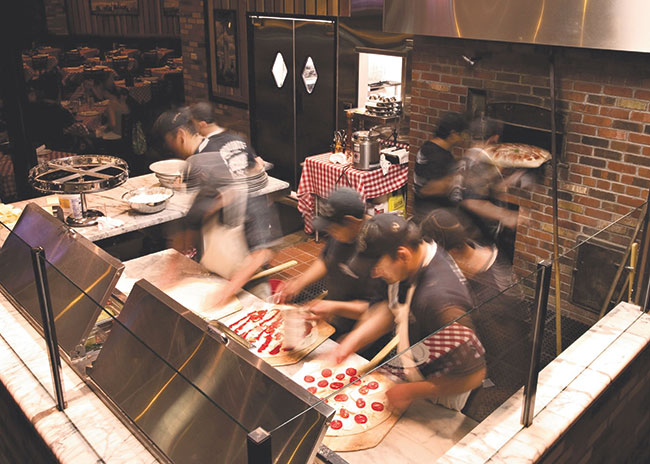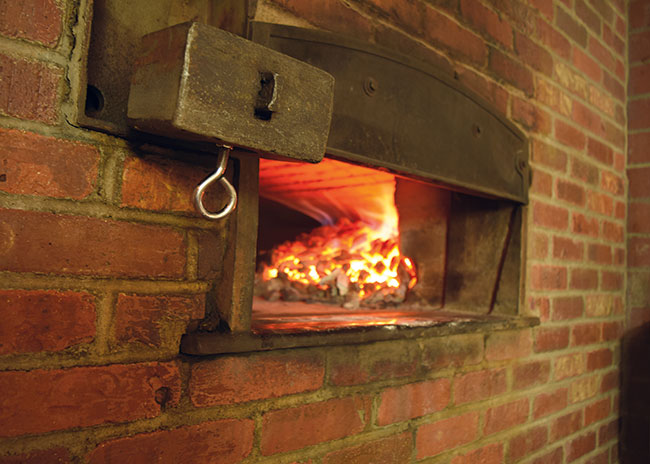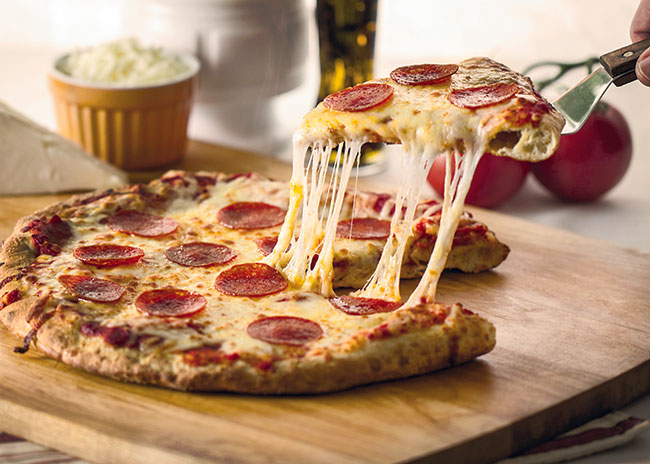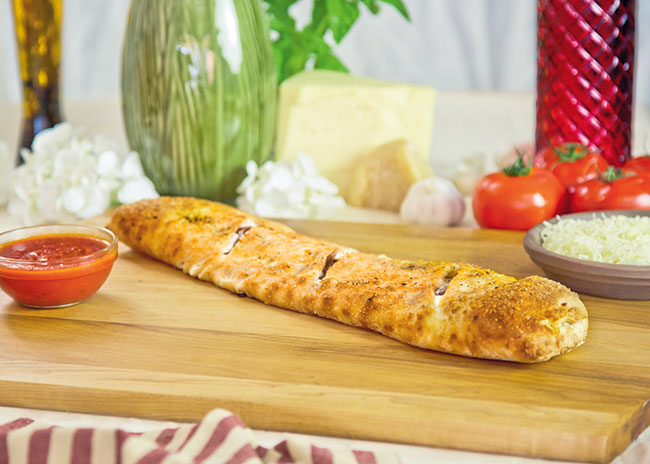Pizzerias represent 10% of all full-service and quick-service restaurants, with about 73,000 pizzerias in the U.S. and 21,000 Italian pizza and pasta restaurants (think Olive Garden, Carrabba’s Italian Grill and California Pizza Kitchen), according to data insights from CHD Expert released in January 2021. A whopping 94% of all Americans eat pizza regularly.

“Pizza has the strongest alignment with delivery, and it’s a comfort food,” says Jay Bandy, president of Atlanta-based Goliath Consulting Group. “Those are the two big forces that makes it resilient.”
Pizza and the Pandemic
Pizza kitchens are expanding, says Bandy, even as overall lease spaces are getting smaller. Notable components that today’s pizza operators continue to add with greater frequency include holding cabinets and shelving units for efficient customer pickups. Going by the wayside, mainly, are call desks as digital orders replace the need for them, according to Bandy.
An increase in online orders has impacted production at Andolini’s five Oklahoma locations, pushing out tables from the front of house and pulling in hot-holding cabinets.
“These hold our pizzas for curbside delivery,” says Mike Bausch, owner of Andolini’s. “We also needed more packaging, which takes up a bigger footprint, so we added higher shelving in our back-of-house storage area.” Staff now make pizza boxes ahead of time and store them in food-safe plastic bags so they are ready when a rush period hits.
Staying organized and ready for rush periods was a challenge for Punxsy Pizza. The Punxsutawney, Pa.-based restaurant learned to overcome these difficulties during the height of pandemic-induced shifts last year. “Since the pandemic, our delivery sales have gone up, and the hours people eat has been condensed from four hours to two,” says Scott Anthony, owner/operator of Punxsy Pizza.
In addition to utilizing more of its dining room for staging pickup and delivery orders, Punxsy Pizza invested in upgraded delivery equipment, including more insulated bags.
 A small prep area for both the dough and pizza toppings keeps things organized for the culinary team at Grimadali’s.Grimaldi’s, which has approximately 42 locations in 11 states, also was contending with space limitations when its to-go orders doubled last year; these now comprise 20% of the chain’s sales. “The big thing was where to put the to-go boxes, bags and gloves,” says Eric Greenwald, president of the chain. “We take on a small footprint, so it’s like shoving 50 pounds of stuff in a 5-pound bag.” The current kitchen setup, including the oven and expo area, comes in at 1,200 square feet; the average total square feet of a Punxsy Pizza restaurant is 3,800 square feet.
A small prep area for both the dough and pizza toppings keeps things organized for the culinary team at Grimadali’s.Grimaldi’s, which has approximately 42 locations in 11 states, also was contending with space limitations when its to-go orders doubled last year; these now comprise 20% of the chain’s sales. “The big thing was where to put the to-go boxes, bags and gloves,” says Eric Greenwald, president of the chain. “We take on a small footprint, so it’s like shoving 50 pounds of stuff in a 5-pound bag.” The current kitchen setup, including the oven and expo area, comes in at 1,200 square feet; the average total square feet of a Punxsy Pizza restaurant is 3,800 square feet.
 Grimaldi's features coal brick-oven pizza.In terms of additional storage space at Grimaldi’s, Greenwald explains, “During the pandemic we used the dining rooms for these areas as they were closed or very limited dining. Now going forward even with the dining rooms open and doing very well, there is still a giant demand for to-go. We have been very creative in finding space to safely store the additional needed boxes, gloves, warmers.”
Grimaldi's features coal brick-oven pizza.In terms of additional storage space at Grimaldi’s, Greenwald explains, “During the pandemic we used the dining rooms for these areas as they were closed or very limited dining. Now going forward even with the dining rooms open and doing very well, there is still a giant demand for to-go. We have been very creative in finding space to safely store the additional needed boxes, gloves, warmers.”
The restaurant added warmers, shelving and carts, while also designating separate areas for third-party delivery pickups and customer carryout orders.
Off-premises items and added sanitation efforts have become top-of-mind for many restaurant operators. “On a larger scale, there is a huge emphasis on delivery equipment like boxes, hot bags and contact-free spatulas with grabber knobs,” says Scott Wiener, author of “Viva La Pizza! The Art of the Pizza Box” and founder of Scott’s Pizza Tours in New York City. On the equipment side, he’s seeing an uptick in interest in electric ovens.
Equipment Metamorphosis
Pizza oven types have grown considerably over time from large deck ovens to space-saving rapid-cook units and rotating stone wood-fire units, according to Bandy at Goliath Consulting.
 Chef Tony Gemignani, who owns multiple pizza concepts, tops pizzas with everything from purple potatoes to a house-made bourbon barbecue sauce.Most notably, countertop ovens now make adding pizza to existing menus easier for concepts wanting to expand their food offerings. “For coffee shops or cafes that want to get into pizza, smaller speed ovens have become popular,” says Tony Gemignani, chef/owner of multiple pizza concepts. The list of his California restaurants includes Tony’s Pizza Napoletana; Capo’s; Pizza Rock; Slice House; Little Tony’s; Tony’s Coal Fired; and Giovanni Italian Specialties. He is also a master instructor at the International School of Pizza.
Chef Tony Gemignani, who owns multiple pizza concepts, tops pizzas with everything from purple potatoes to a house-made bourbon barbecue sauce.Most notably, countertop ovens now make adding pizza to existing menus easier for concepts wanting to expand their food offerings. “For coffee shops or cafes that want to get into pizza, smaller speed ovens have become popular,” says Tony Gemignani, chef/owner of multiple pizza concepts. The list of his California restaurants includes Tony’s Pizza Napoletana; Capo’s; Pizza Rock; Slice House; Little Tony’s; Tony’s Coal Fired; and Giovanni Italian Specialties. He is also a master instructor at the International School of Pizza.
Gemignani notes that the versatility of speed ovens makes them a good choice for smaller operators, who may want to also use that piece of equipment to make other menu items such as hot sandwiches. On the opposite end of the spectrum, he points to conveyor ovens as a primary piece of cooking equipment for many larger operators. “Conveyor ovens are always easy to use and favored by big chains like Pizza Hut and Domino’s,” he says.
Some operators, notes Gemignani, have converted traditional conveyor ovens into stone conveyors. These electric ovens have a stone bottom and combine convection and radiant heating in one unit, often with the option of injecting steam. This accommodates all types of pizza styles, from New York to Neapolitan.
Electric pizza ovens have gained favor over the past five years, says Gemignani. “Electric ovens offer more precise control over the results; they are versatile, stackable, can handle more volume and recover faster,” he adds.
Andolini’s switched from a gas to an electric oven in its smallest location five years ago due to the temperature variability and added versatility. Bausch eventually replaced the ovens at his other four stores with electric units. “What’s special about electric is we can heat the bottom and top to separate heat levels, and it provides multiple decks that can be set at different temperatures,” he explains.
“Electric cooking decreases the relative humidity in the oven and these ovens stay at desired temperatures for a longer period than wood-fired types,” Wiener explains. “Although wood-fired ovens necessitate trained staff to maintain temperatures and there is guesswork involved, it is a faster process, taking between 90 seconds and three minutes to cook versus electric at four to seven minutes.”
Many operators remain dedicated to more traditional pizza-cooking techniques, including Grimaldi’s, which utilizes coal-fired ovens. “There have been huge technology changes with impingement and conveyor ovens,” Greenwald says. “But we decided to partner with [an oven manufacturer] to create a solid burning fuel unit that’s premanufactured.”
Referred to as “the stage” by the chain, the open kitchen concept allows customers a view of the ovens. Cook time ranges from three to five minutes at temperatures between 800 degrees F and 1,200 degrees F. The back of the house includes a combination salad/dessert station and a small prep area for dough and pizza toppings.
Maximizing Efficiency and Labor
Efficiency acts as a key driver for pizza operators across the board today, says Bandy. “Today’s pizza workstations are designed with the idea of keeping cooks a step or less away from what they need to execute their responsibilities,” he says. “And in-house delivery orders are being separated from third-party delivery orders to improve accuracy and flow.”
“Everything is about the number of steps in the back of house, so we try to minimize these,” says Dan Collier, owner of the eight-store concept PizzaMan Dan in California. “Even if we go into a space that’s already set up, if it makes sense to tear it down and start the design from scratch to reduce the number of steps, we’ll do it.”
In another approach to driving efficiency at the store level, Collier moved dough production off-site. He developed a new dough line at his central commissary, which in turn allows more space at the two makelines per store for pizza prep.
“This central kitchen is dedicated to making our dough,” says Collier. “We estimate a return on investment in less than two years. This is driven by the fact that we’re paying so much in labor, we needed to see where we could invest to save.”
Punxsy Pizza’s Anthony also made a change around how the restaurant handles dough, purchasing another cooler to stage the dough and a second freezer to ensure the restaurant would have enough supply. To accommodate the additional equipment, he rented the space next door and then opened a wall to allow access to the kitchen. Pepperoni remains a popular pizza topping among consumers, which naturally is a staple at Punxsy Pizza.
Pepperoni remains a popular pizza topping among consumers, which naturally is a staple at Punxsy Pizza.
Andolini’s also sought additional cold prep space outside of its existing kitchens. “We acquired a building that had a massive walk-in cooler and turned that into a commissary,” Bausch says. “This alleviated our mounting cold storage concerns at all of our locations. We’re doing all our pre-prep and massive catering orders in the commissary and using the front as a gelateria.”
BOH Workflow and Ghost Kitchens
The key to an efficient back of the house is balancing capacity with workflow and labor — with an eye toward minimizing bottlenecks.
Operators need to decide if the additional space and labor are worth having a second line that the business activates only when volume increases to a predetermined point. “If you increase capacity, then you will have the issue of labor percentages going up, but wait times will go down as will profitability,” Falco says. “For this reason, most pizza operators opt for average capacity. When it’s maxed out, the wait times are longer. But with labor becoming the biggest operating cost of the pizza segment and the additional challenge in finding cooks and dough prep staff, it’s worth it.”
 Punxsy also has strong Stromboli sales.If space were less of an issue at Punxsy Pizza, Anthony says an extra pizza prep table with more and larger containers would help resolve prep issues. The back-of-the-house production format is an assembly line, with parallel production taking place on either side. “There’s not enough width between both sides for staff to move around, so they’re almost back to back with the fry station when saucing pizzas,” he says. “We’re constantly running for an ingredient that’s not on the prep table, dodging people to get to a different cooler.
Punxsy also has strong Stromboli sales.If space were less of an issue at Punxsy Pizza, Anthony says an extra pizza prep table with more and larger containers would help resolve prep issues. The back-of-the-house production format is an assembly line, with parallel production taking place on either side. “There’s not enough width between both sides for staff to move around, so they’re almost back to back with the fry station when saucing pizzas,” he says. “We’re constantly running for an ingredient that’s not on the prep table, dodging people to get to a different cooler.
“Also, fried food like wings became a huge seller this year for us,” Anthony continues. “So, a bigger fry station would be great.”
To enhance its back-of-the-house efficiency, Andolini’s utilizes a cabinet on casters for its dry storage. “We can slide it around the kitchen to save space,” Bausch says. “Everything in our kitchen is on casters and raised for easy use and cleaning.”
Grimaldi’s worked with a rack company to design a more efficient custom system that makes ingredients more accessible. “People from the rack company came in to watch our salad and dessert production, paying particular attention to how staff reached for ingredients,” Greenwald says. “They then designed a whole wall by the salad and dessert line so it’s effortless to access what’s needed.”
Grimaldi’s kitchens have implemented a back-of-the-house design that helps create an easy flow and minimize bottlenecking. “You rarely walk past a person in our back of house,” Greenwald says. “We even have separate POS stations that provide a stand for resting trays of food or dishware.”
In addition, many Grimaldi’s locations converted part of their dining rooms to separate to-go sections pre-COVID. “We used to use space by our bar for carryout, but this is a busy area, and it wasn’t conducive [to fast service],” Greenwald says.
The chain also partnered with Kitchen United and added two ghost kitchen units — one in Scottsdale, Ariz., and the other in Austin, Texas — to handle the overflow from its existing restaurants. These 500-square-foot locations offer the full Grimaldi’s menu. This approach takes the pressure off its traditional sites in those areas and led to additional revenue without impacting business at its other locations.
Ghost kitchens are a burgeoning concept in the pizza segment. “I’m working right now with Crave, a ghost kitchen company out of Boise, Idaho, which is expanding nationwide,” Gemignani says. The mini kitchens replicate the larger kitchen setup, with the mini version intended as primarily an option for delivery programs.
Gemignani worked with West Coast chefs and restaurateurs to build 12 different concepts for the multimillion-dollar business, including pizza and wings. “This business was pretty well researched and involves a group from Sweden that is handling the POS side,” Gemignani says. “The 300-square-foot kitchen is horseshoe-shaped with a conveyor belt in the middle.”
Orders are placed in boxes or containers that are sealed with stickers and coded. The unique codes are scanned and food lands on the conveyor belt, which takes it to another area to be boxed and bagged. Rather than using third-party delivery companies, this concept has its own vetted team of drivers.
“The drivers know the chefs and what was ordered, so it’s more personalized service,” Gemignani explains.
Slice House by Tony Gemignani is a QSR concept in conjunction with Virtual Kitchens that is currently growing in the Bay area. It consists of about a dozen smaller kitchens where pizzas are made, parbaked, refrigerated and boxed for delivery to a dozen hub kitchens. The company conducted research and development with Gemignani to determine the best way to reheat pizzas, box them and send them out. Prior to the pandemic, Slice House was preparing 300 to 500 orders per day. Algorithms determined which hub kitchens needed more product.
“We use hub kitchens to bake the pizzas for delivery by third-party companies,” Gemignani says. “There are only eight SKUs on the menu.”



